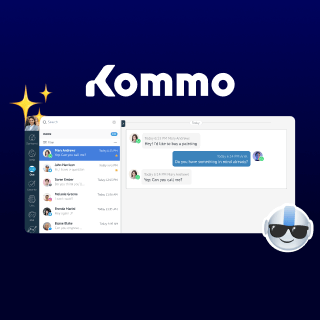WhatsApp Business overview
A paid Kommo account (Base, Advanced, or Enterprise plan) or an active 14-day trial. A personal Facebook account. A dedicated phone number (with country and area code) that can receive SMS or voice calls, supported by the WhatsApp Business Platform.
Authentication templates are not supported in Kommo. Messages sent outside the 24-hour window must use pre-approved templates. Each phone number can only be connected to one Kommo account.
What is WhatsApp Business integration?
Use a phone number on the WhatsApp Business Platform Manage chats directly from Kommo Use automation, team collaboration, and interactive messaging (buttons, forms, carousels, lists)
How WhatsApp Business messaging works in Kommo
-
Flexible replies : Any time a customer sends you a WhatsApp message, a 24-hour “customer service window” opens. During this time, you can chat freely and reply with any message—text, images, or even interactive menus. -
Easy re-engagement : Need to reach out to a customer after 24 hours? Just use a pre-approved WhatsApp template (like a reminder, update, or promo) to pick up where you left off. Templates can also kick off a conversation, even if a customer hasn’t messaged you first. -
Automation ready : Use Salesbot and broadcasts to send updates, confirmations, or campaigns—individually or in bulk—with the right type of message at the right moment. -
Smart workflows : Whether you’re replying to active leads, sending scheduled campaigns, or guiding users with interactive flows, Kommo keeps every chat organized and on track.
Messaging windows and message types
1. Free-form messages
These are regular chat messages—great for fast, natural replies. -
You can send free-form messages only within a 24-hour customer service window . This window starts when a customer sends your business a message. After 24 hours, free-form replies are paused. You’ll need to wait for the customer to write again, or use a template message to keep the conversation going.
2. Template messages
These are pre-approved by Meta, and let you:
Templates also work inside an open conversation. Templates are divided into the following categories:
Conversation windows and special rules
-
24-hour rule : Each time a customer messages you, a 24-hour window opens for free-form replies. After those 24 hours, templates are required to continue the chat. -
Timer : Kommo shows a timer so you always know how much time you have left for free-form messaging. -
Template messages : After the window closes, only template messages are allowed until the customer replies again.
Special case (Ads & Page buttons):
-
You get a 72-hour free messaging window , but only if your business replies within the first 24 hours after the user initiates the conversation. Any type of message (free-form or template) can be sent for free in the first 24 hours. After 24 hours, only templates remain free for the rest of the 72-hour window. Once the window ends, standard template charges apply—unless the customer starts another session by clicking an ad or button again.
WhatsApp Business message pricing
-
Free-form messages within the 24-hour window are free. -
Utility templates are also free if sent during that window, but they’re billed if sent after it. -
Marketing templates and all templates sent after 24 hours are billed per message, based on their category.
WhatsApp Business messaging tools in Kommo
WhatsApp templates
Sending appointment reminders with personalized details Notifying clients about payment confirmations or order updates Sharing promotional messages to re-engage inactive leads
Types of WhatsApp templates
Custom
Sending short updates or alerts Sharing one-time promo codes Following up with personalized messages
Carousel
Promoting several items or offers at once Showcasing service packages or plans in one message Driving traffic to different product pages with clickable cards
Flows
Registering participants for events or webinars Gathering contact or personal info Collecting post-appointment feedback from customers
List messages
Navigating support or help menus Selecting appointment slots or locations Browsing product or service categories without agent assistance
Broadcasting
Sending reminders or important updates Promoting new offers or product launches nviting customers to events or webinars
Salesbot
Guiding new leads through your pipeline Responding instantly to common questions Collecting contact info or booking appointments












